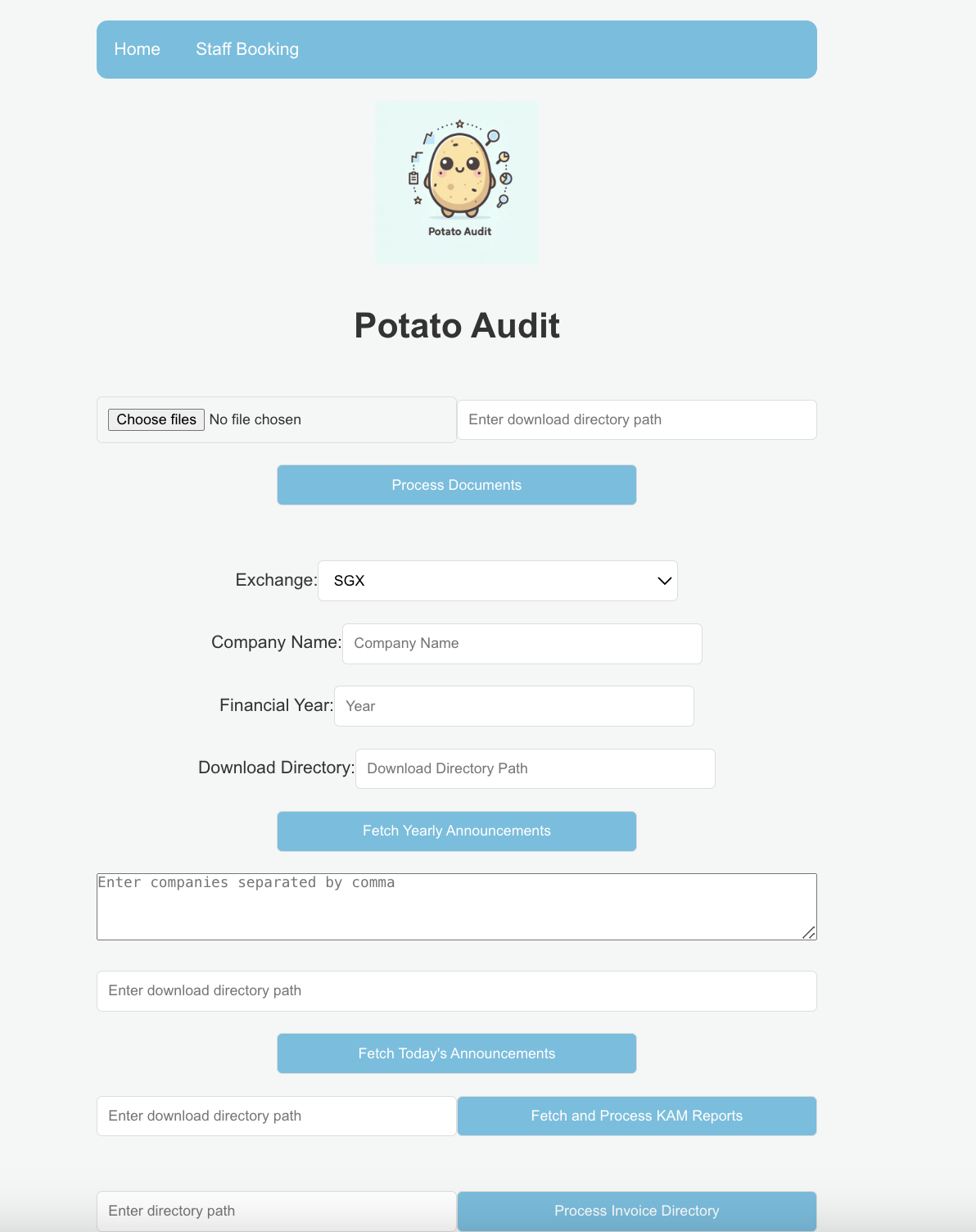Potato Audit
The Problem
Auditors manually processing thousands of documents and announcements, leading to inefficiencies and potential errorsMy Approach
Built an end-to-end automation solution with multiple iterations, ultimately landing on an interactive web interface for document processingThe Journey
1. Problem Identification
During my audit internship, I observed critical inefficiencies:
- Auditors manually matching printed documents with accounting system entries
- Hours spent downloading and compiling public announcements from exchanges
- High risk of human error in data extraction
- Need for structured compilation of data for audit documentation
2. Solution Evolution
Initial Approach: LLM-Based Extraction
Initially attempted using Large Language Models for document parsing:
def extract_fields_llm(text):
prompt = """
As an AI specialized in analyzing invoice documents, extract:
- invoice number
- invoice date
- buyer name
- seller name
- amount before GST
- amount after GST
Format: JSON
Text: {text}
"""
response = llm_client.complete(prompt)
return parse_json(response)
Challenges Faced:
- Slow processing (2-3 seconds per document)
- Inconsistent accuracy (~75%)
- High API costs for production scale
- Difficulty handling varied document formats
Final Approach: Interactive Spatial Recognition
Developed a user-friendly solution using bounding box selection:
@app.route('/process-selected-pairs', methods=['POST'])
def process_selected_pairs():
# Process documents based on user-selected coordinates
invoice_files = [f for f in os.listdir(directoryPath) if f.lower().endswith(('.pdf', '.png'))]
progress['total'] = len(invoice_files)
for index, invoice_file in enumerate(invoice_files):
# Extract text and coordinates from document
processed_path, invoice_blobs, invoice_merged_texts = process_invoice_image(invoice_path)
# Use saved spatial relationships to find corresponding values
for label_text, (dx, dy) in spatial_relationships.items():
label_box = find_coordinates_by_text(label_text, invoice_merged_texts)
if label_box:
value_coords = apply_spatial_relationship(label_box, dx, dy)
closest_box = find_closest_box(dx, dy, value_coords, invoice_merged_texts)
This approach:
- Allows users to visually select label-value pairs in documents
- Saves spatial relationships for future automated processing
- Achieves near 100% accuracy with human verification
- Processes subsequent documents automatically using learned patterns
Exchange Data Automation
Built a scalable scraping system:
- Handles multiple exchanges (SGX, ASX)
- Automated announcement downloads and PDF extraction
- Smart retry mechanisms and rate limiting
- Structured Excel report generation
- Email notification system for daily updates
3. Technical Implementation
Document Processing Pipeline
-
Document Preprocessing
- PDF/Image conversion using Poppler
- OCR with Tesseract
- Text block detection with coordinates
-
Interactive Field Selection
- Web interface for bounding box selection
- Visual confirmation of selected fields
- Spatial relationship learning
- Batch processing with learned patterns
-
Validation & Output
- Preview of extracted fields
- Manual correction if needed
- Excel/JSON export options
- Processing audit trail
Modern Web Interface
- React frontend with Material-UI
- Interactive document viewer
- Real-time processing status
- Batch upload capabilities
- Visual field selection tools
- Export functionality
4. Key Learnings
-
User-Centric Design
- Initially over-engineered with LLMs
- Simplified to intuitive visual interface
- Balance automation with user control
- Importance of immediate visual feedback
-
Automation Strategy
- Learn from user interactions
- Store spatial relationships for reuse
- Handle document variations gracefully
- Maintain high accuracy with minimal user input
-
Technical Evolution
- Started with complex ML approach
- Pivoted to simpler, more reliable solution
- Focused on user experience
- Built for maintainability and scalability
5. Impact
- Reduced document processing time from hours to minutes
- Achieved near 100% accuracy with human verification (~98% for invoice processing, ~28 invoices/min)
- Eliminated manual announcement compilation
- Standardized output format for audit documentation
- Scalable to handle thousands of documents daily
- Received commendation for developing innovative automation solutions
6. Technologies Used
- Frontend: React, Material-UI
- Backend: Flask, Python
- Document Processing: Tesseract OCR, Poppler
- Web Automation: Selenium
- Data Processing: Pandas
- Email Integration: SMTP
- PDF Processing: PyMuPDF
Recognition
Received official commendation from PKF-CAP LLP for developing innovative automation solutions that significantly improved audit efficiency.
View on GitHub
View PDF Introduction
View Testimonial Letter
Impact Metrics
95%
Processing Time Reduction
~100%
Accuracy Rate
1000+
Documents/Day
